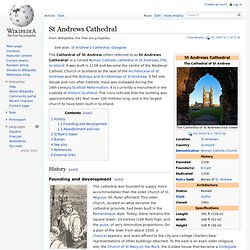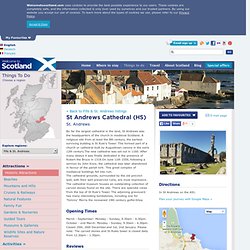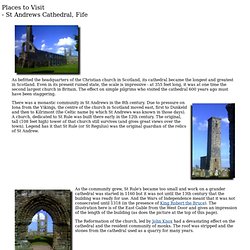

St Rule's Tower Feature Page on Undiscovered Scotland. Sitting at the eastern end of St Andrews' two main streets is the imposing, if slightly confusing, collection of ruins that together make up St Andrews Cathedral.

This was the largest church in medieval Scotland, and probably also the most magnificent. The Cathedral effectively ceased to function after being attacked at the beginning of the Reformation in 1559 and thereafter it served primarily as a quarry for the rest of the town. This helps explain why such an enormous structure should have been reduced to such fragmentary ruins over the centuries. It doesn't however, help explain why the ruins you see today are so confusing. The reason for this is that what you find today are the remains of not one but two churches on the site, plus a third outside the precinct walls.
But the views from the top are worth every step of the climb, and more. The Culdees didn't have long to enjoy their new church, however. St Andrews Cathedral. The Cathedral of St Andrew (often referred to as St Andrews Cathedral) is a ruined Roman Catholic cathedral in St Andrews, Fife, Scotland.

It was built in 1158 and became the centre of the Medieval Catholic Church in Scotland as the seat of the Archdiocese of St Andrews and the Bishops and Archbishops of St Andrews. It fell into disuse and ruin after Catholic mass was outlawed during the 16th-century Scottish Reformation. It is currently a monument in the custody of Historic Scotland. The ruins indicate that the building was approximately 391 feet (over 100 metres) long, and is the largest church to have been built in Scotland. History[edit] Founding and development[edit] Work began on the new cathedral in 1158 and continued for over a century. A fire partly destroyed the building in 1378; restoration and further embellishment were completed in 1440. Greyfriar (Franciscan) and Blackfriar (Dominican) friars had properties in the town by the late 15th century and possibly as late as 1518.
St Andrews Cathedral Feature Page on Undiscovered Scotland. Sitting at the eastern end of St Andrews' two main streets is the imposing, if slightly confusing, collection of ruins that together make up St Andrews Cathedral and a number of associated religious buildings including St Rule's Tower, just to the south east of the cathedral, and St Mary's Church, just outside the precinct wall.

A religious community was probably first located on this site in about 732AD, when relics of St Andrew were brought to what was then known as Kilrimont or Cennrígmonaid by Bishop Acca of Hexam. There is an alternative and probably more fanciful story, that Saint Rule (also known as St Regulus) brought five of St Andrew's bones here by boat in the years after 300AD, having sailed from from Patras in Greece and eventually surviving a shipwreck near the site of today's harbour.
By 1144 St Andrews' place in the Scottish Church was confirmed with the setting up here of a community of Augustinian Canons. Today, what remains is rather fragmentary. Overview of St Andrews Cathedral. ST ANDREWS CATHEDRAL AND ST RULE'S TOWER Property Detail. St Andrews Cathedral (HS) By far the largest cathedral in the land, St Andrews was the headquarters of the church in medieval Scotland.

A religious site from at least the 8th century, the earliest surviving building is St Rule's Tower. This formed part of a church or cathedral built by Augustinian canons in the early 12th century.The new cathedral was set out in 1160. After many delays it was finally dedicated in the presence of Robert the Bruce in 1318.On June 11th 1559, following a sermon by John Knox, the cathedral was later abandoned in favour of the parish kirk. This great complex of mediaeval buildings fell into ruin. The cathedral grounds, surrounded by the old precinct wall, with their well preserved ruins, are most impressive.
March - September: Monday - Sunday, 9.30am - 6.30pm. St Andrews Cathedral St Andrews Scotland. The cathedral has lain in ruins for several hundred year, but it's still a fascinating place to visit .

The date of the first religious community in St Andrews depends on which of the legends you believe. The more credible is that relics of St Andrew were brought to this corner of Fife by Bishop Acca of Hexam in c.732AD. Places to Visit in Scotland - St Andrews Cathedral, Fife. As befitted the headquarters of the Christian church in Scotland, its cathedral became the longest and greatest in Scotland.

Even in its present ruined state, the scale is impressive - at 355 feet long, it was at one time the second largest church in Britain. The effect on simple pilgrims who visited the cathedral 600 years ago must have been staggering. St Andrews Cathedral Tour Information. Last Updated on Sunday, 04 August 2013 11:38 Find Scotland Tours that feature St Andrews Cathedral.

On the site of St Andrews Cathedral, there was originally St Rule's Church, which belonged to a community of Augustinian Canons who had the adjoining building as their living quarters. Nowadays, only the Tower remains, and at 30 meters high, it provides the best panoramic views across St Andrews. St Andrews Cathedral - St Andrews. The remains of St Andrews Cathedral, which was Scotland’s largest cathedral and most magnificent church, show how impressive it used to be.

The museum houses an outstanding collection of early and later medieval sculptures and other relics found on the site, including the magnificent St Andrews Sarcophagus of Pictish date. The precinct walls are particularly well preserved. St Andrews Cathedral and St Rule's Tower. The remains of Scotland's largest cathedral, established in 1160, include 16th century precept walls, 12th and 13th century gables and south wall.

St Rule's Tower - in the cathedral grounds - is part of the first Augustinian church. In the grounds is a museum with collection of early Christian and medieval monuments and relics. HistoryThe story of St Andrew's revolves around the story of the apostle Andrew. According to one version of the story, a monk named Regulus was inspired by an angel to steal the relics of St Andrew and set sail to the island of Thule. He landed instead on this promontory on the coast of Fife and there founded a settlement. The medieval cathedral whose ruins we see today was begun around 1160, and was complete by the late 14th century. Storm clouds over St Rule's Tower.
St Andrews Cathedral and the church of St Regulus. St Andrews Cathedral and the church of St RegulusEngraving: from 'The Baronial and Ecclesiastical Antiquities of Scotland', R.W.

Billings (1845)Source: RIBA British Architectural Library In the Middle Ages, St Andrews was the chief religious site in Scotland. St. Andrews Cathedral - St Andrews and St Leonards, Fife - Scottish Church Heritage Research. Address Cathedral PrecinctSt. AndrewsFifeKY16 9QLScotland. St Rule's Tower Feature Page on Undiscovered Scotland. St Andrews Cathedral - St Rule's Tower. St. Andrews' ghosts : Scotland Magazine Issue 38. The ruins of St Andrews Cathedral in Fife are steeped in history. Gary Hayden reports. In medieval times, St Andrews was the religious centre of Scotland. Its magnificent cathedral housed some of Christendom’s most precious relics (a tooth, an arm-bone, a kneecap and three fingers of St Andrew the Apostle), and pilgrims flocked from far and wide to see them.
BBC - Rebuilding St Andrews Cathedral. The ruins of St Andrews Cathedral. Cardinal David Beaton. John Knox.